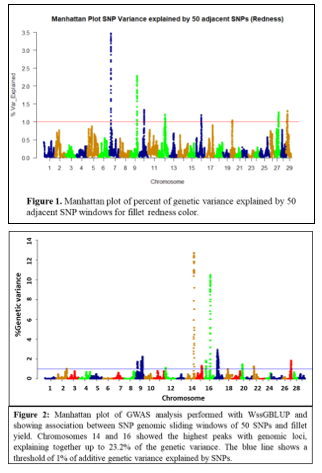GENOMIC SELECTION FOR MUSCLE GROWTH AND FILLET QUALITY TRAITS IN RAINBOW TROUT
Rainbow trout is the most cultivated cold-water fish in the U.S., and muscle fillet is its most valuable product. Increasing fillet yield and reducing fillet downgrading will improve production efficiency, which can have substantial economic benefits.
Genomic selection has been widely used to increase the efficiency of genetic improvement programs in livestock but has yet to be widely adopted in aquaculture. Classical breeding approaches can improve fillet yield but are time-consuming because of long generation intervals. A more efficient approach is to use genomic selection, where thousands of SNP are used as additional information to increase the accuracy of breeding values and reduce generation interval, consequently increasing genetic gain.
The industry’s immense interest is to implement genomic selection in their breeding populations. Using a "functional" 50K SNP-chip developed in our lab, we identified QTL for fillet yield, firmness, color, protein, and fat contents. We demonstrated the utility of the genomic selection in rainbow trout. Our studies show that the genomic predictions can improve the estimated breeding values by 33.3% for the fillet yield and 53.1% for fillet firmness. The genomic predictions outperformed the traditional breeding by 35% for fillet yield and 42% for fillet firmness. Additionally, reducing SNP panel densities indicated that using ~1000 SNPs in genomic predictions still provides predictive abilities higher than traditional breeding. These results suggest that genomic evaluation is a feasible strategy to identify and select fish with superior genetic merit within rainbow trout families, even with low-density SNP panels.

